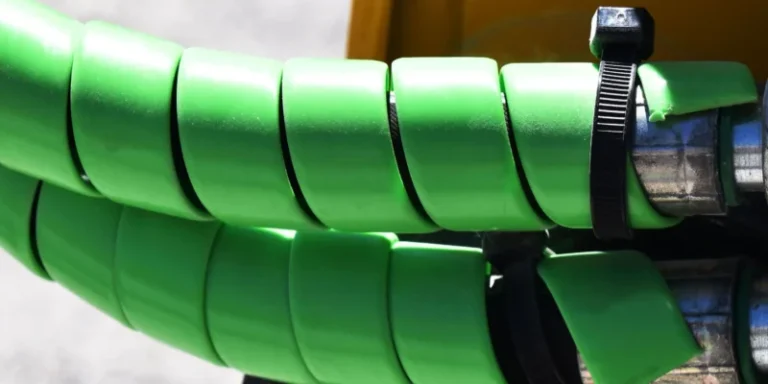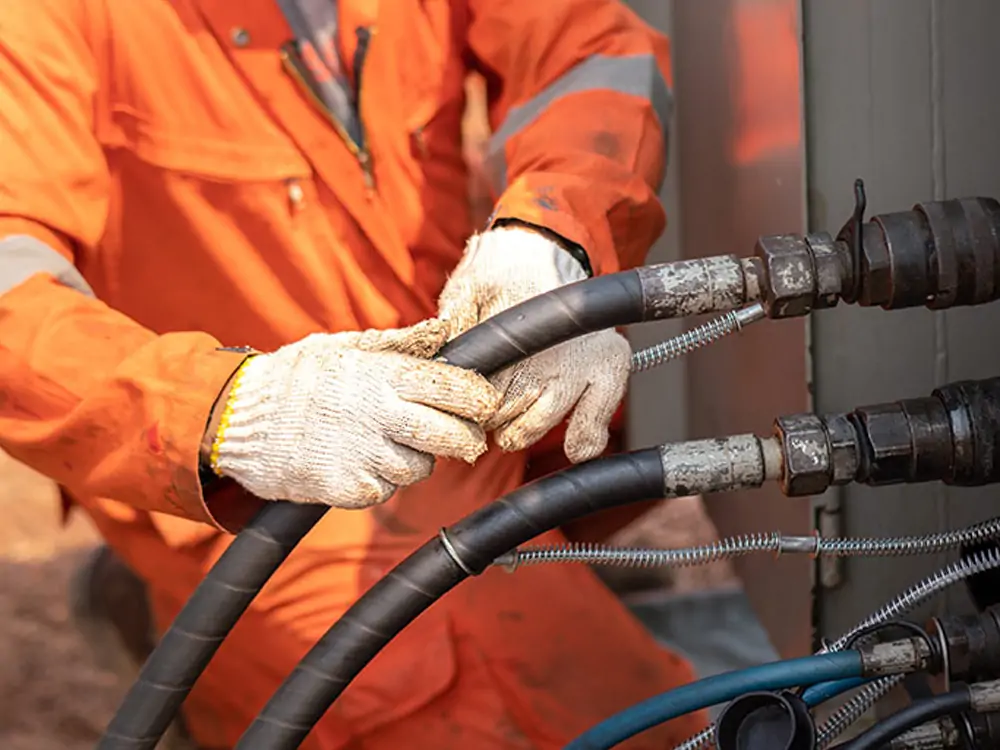Industrial and hydraulic hoses are indispensable parts of countless applications across various industries. We may find them in manufacturing, construction, agriculture, or heavy machinery applications. They are crucial in transferring fluids, gases, and other materials. Whatever the application is, a hydraulic hose plays a pivotal role in ensuring the smooth operation of machinery. Indeed, their reliability directly impacts productivity, safety, and cost-efficiency. However, we can provide this hose’s reliability by protecting it from some hazards. Therefore, we came up with this article explaining the tips on industrial and hydraulic hose protection.
Hydraulic hoses are designed to endure demanding conditions but are still not invulnerable. Over time, a few factors may create wear and tear to the hose. These factors include exposure to harsh environments, pressure fluctuations, abrasion, and mechanical stress. They potentially create leaks, inefficiencies, or even catastrophic failure. It is where the significance of protecting industrial and hydraulic hoses comes to the forefront.
This article aims to provide a lesson on safeguarding the performance of hydraulic hoses. We will discuss the five popular tips that every professional should consider. Besides, we will talk about the factors that affect the lifespan of an industrial or hydraulic hose. We will also discuss some popular hydraulic hose protection equipment that may solve our problems. By following these guidelines, readers can enhance their hydraulic system’s reliability and safety.
Industrial And Hydraulic Hose Protection: 5 Tips For Durable Performance
We will explore five fundamental industrial hose protection aspects below. By understanding and implementing these tips, you can significantly extend the lifespan of your hoses. It also enhances system efficiency and minimizes the risk of unexpected failures.
1. Use High-quality Hose
Regarding hydraulic systems, the choice of hose quality matters a lot. It can differ between seamless, efficient operations and frequent breakdowns or leaks. High-quality hydraulic hoses are engineered to withstand high pressures. They can also adapt themselves to different demanding conditions. Moreover, high-quality hydraulic hoses ensure safety, durability, efficiency, and cost savings.
Reputable hydraulic hoses are typically constructed with layers of synthetic rubber. Some industrial hoses may have thermoplastic materials reinforced with wire braids or spirals.
However, while choosing suitable materials specifications, looking for three key specifications is essential:
- Ensure the hose’s pressure rating matches or exceeds the system’s requirements.
- Select hoses designed to operate within the expected temperature for your application.
- Please verify that the hose is compatible with the conveyed fluid.
Furthermore, trustworthy manufacturers are typically famous for producing high-quality products. Rentone Hose is a renowned industrial and hydraulic hose manufacturer. They make all types of hoses with high-quality finishing. They keep the latest machinery in their production line. Therefore, if you are looking for a suitable hydraulic hose manufacturer, Rentone Hose is the place for you. Above all, we suggest you invest in your hydraulic systems’ safety and efficiency by opting for high-quality hoses. Ultimately, the right decision saves your operations from costly repairs.
2. Proper Installation And Routing
Improper installation and routing are common incidents behind premature hydraulic hose wear. In addition, it leads to system inefficiencies and failures. The consequences of improper installation and routing can be severe. In this case, abrasion, wear, pressure drops, and safety hazards are noteworthy.
We have already prepared some articles explaining how hydraulic hoses are installed. “How to connect hydraulic hoses” briefly describes the hose connection method. In addition, “How to replace hydraulic hoses” highlights the right way of replacing and installing the hydraulic hose. Let’s have a quick tour of the correct steps for hydraulic hose installation:
- Examine hoses for damage or defects before installation.
- Ensure the hose’s length and diameter are suitable for the application to prevent unnecessary stress.
- Route hoses to minimize bending and twisting during operation. In this case, you can use support clamps to maintain alignment.
- Secure the hoses with appropriate fittings, connectors, and clamps. It prevents movement or detachment.
- Follow the manufacturer’s recommended minimum bend radius to prevent kinks or sharp bends.
- Employ hose protectors, if necessary. It shields against abrasion and environmental factors.
- Periodically check hoses for wear, misalignment, or damage.
Moreover, sharp bends and kinks can restrict fluid flow. It also weakens the hose structure and causes premature failure. Therefore, adhere to proper routing techniques and minimize tight bends. So you can maintain optimal hose performance and ensure an extended, durable lifespan.
Hydraulic Line Protector
Hydraulic hose protectors are another crucial piece of equipment safeguarding hydraulic hoses. They also ensure the hose’s durability and prevent damage that can lead to costly repairs. The role of a hydraulic line protector is to act as a shield, guarding hoses against various hazards. These hazards may include abrasion, impact, UV exposure, or other environmental contaminants.
There are different types of hose protectors based on different types of hose. Hydraulic hose wrap, hydraulic hose protective sleeve, and abrasion-resistant covers are noteworthy. We will discuss more of the types in the later sections. However, choosing the suitable hose protector depends on several factors. It includes application, hose size, flexibility, material compatibility, and environmental conditions.

Regular Hydraulic Hose Maintenance
Maintaining hydraulic hoses is more than just a task. It is an essential practice that can significantly extend the lifespan of these critical components. It also ensures the safety and efficiency of industrial operations. The significance of routine maintenance must be balanced. Firstly, regular maintenance identifies potential issues before they happen. It reduces costly downtime and production losses.
Secondly, well-maintained hoses minimize the risk of hazardous fluid leaks. It protects personnel and the environment. Thirdly, cleaning, inspecting, and replacing hoses as needed ensure hydraulic systems operate efficiently. It ultimately extends the life of costly components.
A well-structured maintenance schedule includes regular inspections, cleaning, pressure testing, and replacement. If you identify early signs of hose wear and damage during these steps, you should take the necessary steps ASAP. These issues might include abrasion, bulges, blistering, leaking fluid, soft spots, kinks, and twists.
Proper Application
Choosing the proper hydraulic hose for a specific application is paramount to system performance. It directly affects your hydraulic system’s efficiency, reliability, and safety. The correct hose ensures that your hydraulic system operates at peak efficiency. It also provides that it can achieve maximum power and responsiveness.
Moreover, an ideal hydraulic hose minimizes the risk of leaks, bursts, and other failures. Inappropriate products can result in accidents or damage to equipment. In addition, a well-matched hydraulic hose is less prone to wear and damage.
Besides, don’t hesitate to seek advice from hydraulic experts or engineers when in doubt about hose selection. You can also seek assistance from the manufacturer’s customer service. They can help assess your requirements and recommend suitable hoses. Consequently, they can provide valuable insights into system design and maintenance.
What Affects The Lifespan of An Industrial or Hydraulic Hose?
The lifespan of an industrial or hydraulic hose can be significantly affected by a wide range of factors. The following points discuss how the mentioned factors can impact the hose’s performance.
- Abrasion: Frequent contact with rough surfaces or material can wear down the hose’s outer cover. Consequently, it reduces the hose’s lifespan and leads to potential leaks.
- Contamination: Particles or debris in the conveyed fluid can cause internal damage. It mainly creates blockages.
- Chemical Exposure: Exposure to chemicals or corrosive substances can degrade hose materials. It may lead to reduced integrity and potential failure.
- Corrosion: Corrosive substances or environmental factors can corrode metal components within the hose. It ultimately compromises the hose’s strength and longevity.
- Environmental Factors: Exposure to elements can deteriorate the hose’s outer cover and materials. Environmental factors like UV radiation, ozone, and weather conditions are noteworthy. Besides, extreme cold and heat may affect the hose’s flexibility and material integrity.
- Fluid Incompatibility: Incompatible hose materials with the conveyed fluid may create chemical reactions. It may degrade the material, leading to hose failure.
- Hydraulic Shock: Rapid changes in pressure, known as pressure spikes, can weaken the hose structure. It may lead to rupture or leakage.
- Other factors like moisture, pressure, repeated strain, and vibration affect hydraulic hose performance.

Industrial And Hydraulic Hose Protection Equipment
Industrial and hydraulic hose protection equipment is essential to hose safety and durability. These types of equipment protect hoses from various wear, abrasion, and environmental factors. We have already discussed these factors in the previous section. The following are some popular industrial and hydraulic hose protection equipment.
- Hydraulic hose sleeves are cylindrical covers that slip over hydraulic hoses. It shields the hoses from abrasion, impact, UV radiation, and environmental elements. Rubber hose protection sleeves are made from materials designed to withstand harsh conditions.
- Hydraulic hose spiral wraps are the most famous hydraulic hose protection equipment. They are flexible, coiled protectors that spiral around hydraulic hoses. Spiral hose protection offers excellent abrasion resistance and flexibility. In addition, rubber hose protection wraps are handy for protecting hoses exposed to constant friction.
- Clamps are used to secure hoses to fittings or connectors. It ensures a tight and leak-free connection.
- End connections refer to the fittings, coupling an adaptor. They are used to connect hoses to the result of the hydraulic system.
- Reinforcement layers are often made of high-strength materials like steel wire or textiles. It provides additional structural support and helps hoses withstand internal and external pressures.
Conclusion
In conclusion, safeguarding hydraulic hoses is not a mere precaution. It ensures the longevity, reliability, and safety of a hydraulic system. Therefore, prioritizing the abovementioned five points can mitigate risks. These five aspects also enhance operational efficiency. In addition, they also minimize downtime and associated costs.
Above all, if you have any questions regarding hydraulic hose protection equipment, please get in touch with us. You can also seek assistance to learn more about their role in the hydraulic system.
